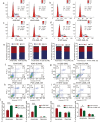Junctional adhesion molecule-like protein promotes tumor progression via the Wnt/β-catenin signaling pathway in lung adenocarcinoma
- PMID: 35672776
- PMCID: PMC9171988
- DOI: 10.1186/s12967-022-03457-w
Junctional adhesion molecule-like protein promotes tumor progression via the Wnt/β-catenin signaling pathway in lung adenocarcinoma
Abstract
Background: Lung adenocarcinoma (LUAD) is a heavy social burden worldwide. Because the mechanisms involved in LUAD remain unclear, the prognosis of LUAD remains poor. Consequently, it is urgent to investigate the potential mechanisms of LUAD. Junctional adhesion molecule-like protein (JAML), is recognized as a tumorigenesis molecule in gastric cancer. However, the role of JAML in LUAD is still unclear. Here we aimed to evaluate the role of JAML in LUAD.
Methods: qRT-PCR, Western blotting and immunohistochemistry were conducted to investigate the expression of JAML in LUAD tissues. JAML was knocked down and overexpressed in LUAD cells using transient transfection by siRNA and plasmids or stable transfection by lentivirus. Proliferation potential of LUAD cells were detected by Cell Counting Kit-8, EdU incorporation and Colony formation assay. Migration and invasion abilities of LUAD cells were determined by wound healing, transwell migration and invasion assays. Cell cycle and cell apoptosis were detected by flow cytometry. The effects of JAML in vivo were studied in xenograft tumor models. Western blotting was used to explore the molecular mechanisms of JAML function. In addition, rescue experiments were performed to verify the possible mechanisms.
Results: JAML expression was elevated in LUAD tissues compared with peritumor tissues, and this upregulation was positively related to pT and pTNM. Furthermore, both in vitro and in vivo, JAML silencing markedly repressed malignant behaviors of LUAD cells and vice versa. Knockdown of JAML also mediated cell cycle arrest at G0/G1 phase and promoted apoptosis in LUAD cells. Mechanistically, silencing JAML repressed the process of epithelial-mesenchymal transition by inactivating the Wnt/β-catenin pathway in LUAD cells. Effects of JAML can be rescued by Wnt/β-catenin pathway activator in A549 cells.
Conclusions: Our data reveal the oncogenic role of JAML in LUAD, indicating that JAML may be a predictive biomarker and novel therapeutic target for LUAD.
Keywords: Invasion; Junctional adhesion molecule-like protein; Lung adenocarcinoma; Migration; Tumor progression.
© 2022. The Author(s).
Conflict of interest statement
The authors declare no confict of interest.
Figures








Similar articles
-
Junctional adhesion molecule-like protein as a novel target for kaempferol to ameliorate lung adenocarcinoma.J Integr Med. 2023 May;21(3):268-276. doi: 10.1016/j.joim.2023.03.009. Epub 2023 Apr 6. J Integr Med. 2023. PMID: 37069006
-
GINS1 facilitates the development of lung adenocarcinoma via Wnt/β-catenin activation.World J Surg Oncol. 2025 Apr 7;23(1):122. doi: 10.1186/s12957-025-03786-2. World J Surg Oncol. 2025. PMID: 40197379 Free PMC article.
-
NTSR1 promotes epithelial-mesenchymal transition and metastasis in lung adenocarcinoma through the Wnt/β-catenin pathway.Mutat Res. 2024 Jul-Dec;829:111877. doi: 10.1016/j.mrfmmm.2024.111877. Epub 2024 Aug 10. Mutat Res. 2024. PMID: 39180939
-
RBM15 facilities lung adenocarcinoma cell progression by regulating RASSF8 stability through N6 Methyladenosine modification.Transl Oncol. 2024 Aug;46:102018. doi: 10.1016/j.tranon.2024.102018. Epub 2024 Jun 4. Transl Oncol. 2024. PMID: 38838436 Free PMC article. Review.
-
Cell Type-Specific Roles of STAT3 Signaling in the Pathogenesis and Progression of K-ras Mutant Lung Adenocarcinoma.Cancers (Basel). 2022 Mar 31;14(7):1785. doi: 10.3390/cancers14071785. Cancers (Basel). 2022. PMID: 35406557 Free PMC article. Review.
Cited by
-
m6A modification of CDC5L promotes lung adenocarcinoma progression through transcriptionally regulating WNT7B expression.Am J Cancer Res. 2024 Jul 15;14(7):3565-3583. doi: 10.62347/QHFA9669. eCollection 2024. Am J Cancer Res. 2024. PMID: 39113868 Free PMC article.
-
JAML inhibits colorectal carcinogenesis by modulating the tumor immune microenvironment.In Vitro Cell Dev Biol Anim. 2024 Apr;60(4):382-396. doi: 10.1007/s11626-024-00881-8. Epub 2024 Apr 16. In Vitro Cell Dev Biol Anim. 2024. PMID: 38625487
-
Macrophage junctional adhesion molecule-like (JAML) protein promotes NLRP3 inflammasome activation in the development of atherosclerosis.Cell Death Differ. 2025 Mar 28. doi: 10.1038/s41418-025-01489-5. Online ahead of print. Cell Death Differ. 2025. PMID: 40148467
-
RPS24 Is Associated with a Poor Prognosis and Immune Infiltration in Hepatocellular Carcinoma.Int J Mol Sci. 2023 Jan 2;24(1):806. doi: 10.3390/ijms24010806. Int J Mol Sci. 2023. PMID: 36614249 Free PMC article.
-
Prognostic model of lung adenocarcinoma from the perspective of cancer-associated fibroblasts using single-cell and bulk RNA-sequencing.Sci Rep. 2025 Jul 1;15(1):21961. doi: 10.1038/s41598-025-05058-1. Sci Rep. 2025. PMID: 40592920 Free PMC article.
References
-
- Chen W, Zheng R, Baade P, Zhang S, Zeng H, Bray F, et al. Cancer statistics in China. CA A Cancer J Clin. 2016;66(2):115–32. - PubMed
-
- Siegel R, Miller K, Jemal A. Cancer statistics 2015: cancer. CA A Cancer J Clin. 2015;65(1):5–29. - PubMed
-
- Tian Y, Tian Y, Zhang W, Wei F, Yang J, Luo X, et al. Junctional adhesion molecule-a, an epithelial-mesenchymal transition inducer, correlates with metastasis and poor prognosis in human nasopharyngeal cancer. Carcinogenesis. 2015;36(1):41–48. - PubMed
Publication types
MeSH terms
Substances
LinkOut - more resources
Full Text Sources
Medical
Molecular Biology Databases

